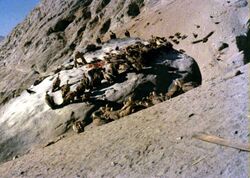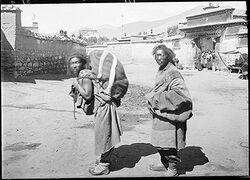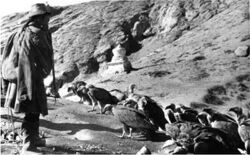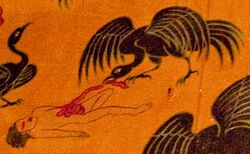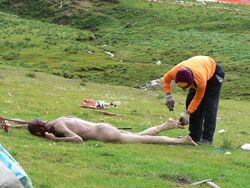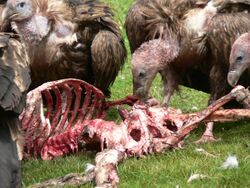Unsolved:Sky burial
Sky burial (Tibetan: བྱ་གཏོར་, Wylie: bya gtor, lit. "bird-scattered"[1]) is a funeral practice in which a human corpse is placed on a mountaintop to decompose while exposed to the elements or to be eaten by scavenging animals, especially carrion birds like vultures and corvids. It is a specific type of the general practice of excarnation. It is practiced in the Chinese provinces and autonomous regions of Tibet, Qinghai, Sichuan, and Inner Mongolia, as well as in Mongolia, Bhutan, and parts of India such as Sikkim and Zanskar.[2] The locations of preparation and sky burial are understood in the Vajrayana Buddhist traditions as charnel grounds. Comparable practices are part of Zoroastrian burial rites where deceased are exposed to the elements and scavenger birds on stone structures called Dakhma.[3] Few such places remain operational today due to religious marginalisation, urbanisation and the decimation of vulture populations.[4][5]
The majority of Tibetan people and many Mongols adhere to Vajrayana Buddhism, which teaches the transmigration of spirits. There is no need to preserve the body, as it is now an empty vessel. Birds may eat it or nature may cause it to decompose. The function of the sky burial is simply to dispose of the remains in as generous a way as possible (the origin of the practice's Tibetan name). In much of Tibet and Qinghai, the ground is too hard and rocky to dig a grave, and due to the scarcity of fuel and timber, sky burials were typically more practical than the traditional Buddhist practice of cremation. In the past, cremation was limited to high lamas and some other dignitaries,[6] but modern technology and difficulties with sky burial have led to an increased use of cremation by commoners.[7][unreliable source?]
Other nations which performed air burial were the Caucasus nations of Georgians, Abkhazians, and Adyghe people, in which they put the corpse in a hollow tree trunk.[8][9]
Name
"Sky burial" is a Western term; it is not used by Tibetans, who call it "giving alms to the birds" or "to carry to the mountain." The latter term describes the vultures defecating on the mountains after eating.[10]
History and development
The Tibetan sky-burials appear to have evolved from ancient practices of defleshing corpses as discovered in archeological finds in the region.[11] These practices most likely came out of practical considerations,[12][13][14] but they could also be related to more ceremonial practices similar to the suspected sky burial evidence found at Göbekli Tepe (11,500 years before present) and Stonehenge (4,500 years BP).[citation needed] Most of Tibet is above the tree line, and the scarcity of timber makes cremation economically unfeasible. Additionally, subsurface interment is difficult since the active layer is not more than a few centimeters deep, with solid rock or permafrost underlying the surface.
The customs are first recorded in an indigenous 12th-century Buddhist treatise, which is colloquially known as the Book of the Dead (Bardo Thodol).[15] Tibetan tantricism appears to have influenced the procedure.[16][17] The body is cut up according to instructions given by a lama or adept.[18]
Mongolians traditionally buried their dead (sometimes with human or animal sacrifice for the wealthier chieftains), but the Tümed adopted sky burial following their conversion to Tibetan Buddhism under Altan Khan during the Ming dynasty. Other banners subsequently converted under the Manchu Qing dynasty.[19]
Sky burial was initially treated as a primitive superstition and sanitation concern by the Communist governments of both the PRC and Mongolia; both states closed many temples[19] and China banned the practice completely from the Cultural Revolution of the late 1960s until the 1980s.[20] During this period, sky burials were considered among the Four Olds, which was the umbrella term used by Communists to describe anti-proletarian customs, cultures and ideas. As a result of these policies, many corpses would simply be buried or thrown in rivers. Many families believed the souls of these people would never escape purgatory and became ghosts. Sky burial nonetheless continued to be practiced in rural areas and has even received official protection in recent years. However, the practice continues to diminish for a number of reasons, including restrictions on its practice near urban areas and diminishing numbers of vultures in rural districts. Finally, Tibetan practice holds that the yak carrying the body to the charnel grounds should be set free, making the rite much more expensive than a service at a crematorium.[21]
Purpose and meaning
For Tibetan Buddhists, sky burial and cremation are templates of instructional teaching on the impermanence of life.[18] Jhator is considered an act of generosity on the part of the deceased, since the deceased and their surviving relatives are providing food to sustain living beings. Such generosity and compassion for all beings are important virtues in Buddhism.[22]
Although some observers have suggested that jhator is also meant to unite the deceased person with the sky or sacred realm, this does not seem consistent with most of the knowledgeable commentary and eyewitness reports, which indicate that Tibetans believe that at this point life has completely left the body and the body contains nothing more than simple flesh.
Only people who directly know the deceased usually observe it, when the excarnation happens at night.
Vajrayana iconography
The tradition and custom of the jhator afforded Traditional Tibetan medicine and thangka iconography with a particular insight into the interior workings of the human body. Pieces of the human skeleton were employed in ritual tools such as the kapala (skullcup) and kangling (thigh-bone trumpet).
The 'symbolic bone ornaments' (Sanskrit: Script error: The function "transl" does not exist.; Tibetan: rus pa'i rgyan phyag rgya) are also known as "mudra" or 'seals'. The Hevajra Tantra identifies the Symbolic Bone Ornaments with the Five Wisdoms and Jamgon Kongtrul in his commentary to the Hevajra Tantra explains this further.[23]
Setting
A traditional jhator is performed in specified locations in Tibet (and surrounding areas traditionally occupied by Tibetans). Drigung Monastery is one of the three most important jhator sites.
The procedure takes place on a large flat rock long used for the purpose. The charnel ground (durtro) is always higher than its surroundings. It may be very simple, consisting only of the flat rock, or it may be more elaborate, incorporating temples and stupa (chorten in Tibetan).
Relatives may remain nearby[24] during the jhator, possibly in a place where they cannot see it directly. The jhator usually takes place at dawn.
The full jhator procedure (as described below) is elaborate and expensive. Those who cannot afford it simply place their deceased on a high rock where the body decomposes or is eaten by birds and animals.
In 2010, a prominent Tibetan incarnate lama, Metrul Tendzin Gyatso, visited the sky burial site near the Larung Gar Buddhist Institute in Sertar County, Sichuan, and was dismayed by its poor condition. With the stated goal of restoring dignity to the dead and creating a better environment for the vultures, the lama subsequently rebuilt and improved the platform where bodies are cut up, adding many statues and other carved features around it, and constructed a large parking lot for the convenience of visitors.[25]
Procedure
Accounts from observers vary. The following description is assembled from multiple accounts by observers from the U.S. and Europe.
Participants
Prior to the procedure, monks may chant mantra around the body and burn juniper incense – although ceremonial activities often take place on the preceding day.
The work of disassembling of the body may be done by a monk, or, more commonly, by rogyapas ("body-breakers"). All the eyewitness accounts remarked on the fact that the rogyapas did not perform their task with gravity or ceremony, but rather talked and laughed as during any other type of physical labor. According to Buddhist teaching, this makes it easier for the soul of the deceased to move on from the uncertain plane between life and death onto the next life.
Some accounts refer to individuals who carry out sky burial rituals as a tokden which is Tibetan for 'master' of the process. While a Tokden has an important role in burial rites, they are often people of low social status and sometimes receive payment from the families of the deceased.
Disassembling the body
According to most accounts, vultures are given the whole body. Then, when only the bones remain, these are broken up with mallets, ground with tsampa (barley flour with tea and yak butter, or milk) and given to the crows and hawks that have waited for the vultures to depart.
In one account, the leading rogyapa cut off the limbs and hacked the body to pieces, handing each part to his assistants, who used rocks to pound the flesh and bones together to a pulp, which they mixed with tsampa before the vultures were summoned to eat. In some cases, a Tokden will use butcher's tools to divide the body.
Sometimes the internal organs were removed and processed separately, but they too were consumed by birds. The hair is removed from the head and may be simply thrown away; at Drigung, it seems, at least some hair is kept in a room of the monastery.
None of the eyewitness accounts specify which kind of knife is used in the jhator. One source states that it is a "ritual flaying knife" or trigu (Sanskrit kartika), but another source expresses skepticism, noting that the trigu is considered a woman's tool (whereas rogyapas seem to be exclusively male).
Vultures
The species contributing to the ritual are typically the Himalayan and griffon vultures.
In places where there are several jhator offerings each day, the birds sometimes have to be coaxed to eat, which may be accomplished with a ritual dance. If a small number of vultures come down to eat, or if portions of the body are left over after the vultures fly away, or if the body is completely left untouched, it is considered to be a bad omen in Buddhist beliefs.[26] In these cases, according to Buddhist belief, there are negative implications for the individual and/or the individual's family, such as the individual being buried having lived a bad life or accumulated bad karma throughout their lifetime and throughout their past lives, thus predetermining them to a bad rebirth.[27]
In places where fewer bodies are offered, the vultures are more eager, and sometimes have to be fended off with sticks during the initial preparations. Often there is a limit to how many corpses can be consumed at a certain burial site, prompting lamas to find different areas. It is believed that if too many corpses are disposed in a certain burial site, ghosts may appear.
Not only are vultures an important aspect to celestial burial but also to its habitat's ecology. They contribute to carcass removal and nutrient recycling, as they are scavengers of the land.[28] Due to an alarming drop in their population, in 1988, the Law of the People's Republic of China on the Protection of Wildlife added certain species of vultures into the "rare" or "threatened" categories of their national list of protected wild animals.[29] Local Chinese governments surrounding sky burial locations have established regulations to avoid disturbance of the vultures during these rituals, as well as to not allow individuals who have died due to infectious diseases or toxicosis from receiving a sky burial in order to prevent compromising the health of the vultures.[30]
See also
- Medicine:Disposal of human corpses – Burial methods
- Religion:Tower of Silence – Zoroastrian excarnation structure
- Burial at sea
References
- ↑ "How Sky Burial Works". 25 July 2011. http://people.howstuffworks.com/culture-traditions/cultural-traditions/sky-burial.htm.
- ↑ Sulkowsky, Zoltan (2008). Around the World on a Motorcycle. Whitehorse Press. p. 114. ISBN 9781884313554. https://octanepress.com/book/around-world-motorcycle.
- ↑ BBC. "Zoroastrian funerals Towers of Silence". 02 Oct 2009. Accessed 08 Sep 2014.
- ↑ New York Times. "Giving New Life to Vultures to Restore a Human Ritual of Death". 29 Nov 2012. Accessed 08 Sep 2014.
- ↑ NPR. "Vanishing Vultures A Grave Matter For India's Parsis". 05 Sep 2012. Accessed 08 Sep 2014.
- ↑ "Sky Burial, Tibetan Religious Ritual, Funeral Party". http://www.travelchinaguide.com/cityguides/tibet/sky-buria.htm.
- ↑ China Daily. "Funeral reforms in Tibetan areas". 13 Dec 2012. Accessed 18 Jul 2013.
- ↑ "ИСТОРИЯ ГРУЗИИ" (in ru). http://www.vostlit.info/Texts/rus11/Bagrationi/frametext1.htm.
- ↑ "ОПИСАНИЕ КОЛХИДЫ ИЛИ МИНГРЕЛИИ" (in ru). http://www.vostlit.info/Texts/Dokumenty/Kavkaz/XVII/1640-1660/Lamberti/text.htm.
- ↑ Wentmore, Kevin J. (2021) Eaters of the Dead, London: Reaktion Books, p. 27
- ↑ PBS. "Cave People of the Himalaya".
- ↑ Wylie 1965, p. 232.
- ↑ Martin 1996, pp. 360–365.
- ↑ Joyce & Williamson 2003, p. 815.
- ↑ Martin 1991, p. 212.
- ↑ Ramachandra Rao 1977, p. 5.
- ↑ Wylie 1964.
- ↑ 18.0 18.1 Goss & Klass 1997, p. 385.
- ↑ 19.0 19.1 Heike, Michel. "The Open-Air Sacrificial Burial of the Mongols". Accessed 18 Jul 2013.
- ↑ Faison 1999, para. 13.
- ↑ "Funeral reforms edge along in Tibetan areas". Xinhua. 2012-12-13. http://english.sina.com/china/2012/1213/537423.html.
- ↑ Mihai, Andrei (November 9, 2009). "The Sky Burial". http://www.zmescience.com/other/the-sky-burial/.
- ↑ Kongtrul 2005, p. 493.
- ↑ Ash 1992, p. 59.
- ↑ "喇榮五明佛學院屍陀林:帶你走進生命輪迴的真相". 28 September 2016. https://read01.com/a78nP7.html#.XbiyNi-ZNhE.
- ↑ MaMing, Roller; Lee, Li; Yang, Xiaomin; Buzzard, Paul (2018-03-29). "Vultures and sky burials on the Qinghai-Tibet Plateau". Vulture News 71 (1): 22. doi:10.4314/vulnew.v71i1.2. ISSN 1606-7479. https://www.ajol.info/index.php/vulnew/article/view/168874.
- ↑ Gouin, Margaret (2010). Tibetan Rituals of Death: Buddhist Funerary Practices. Routledge. p. 70. ISBN 9780203849989.
- ↑ MaMing, Roller; Xu, Guohua (2015-11-12). "Status and threats to vultures in China". Vulture News 68 (1): 10. doi:10.4314/vulnew.v68i1.1. ISSN 1606-7479. http://www.ajol.info/index.php/vulnew/article/view/125620.
- ↑ MaMing, Roller; Xu, Guohua (2015-11-12). "Status and threats to vultures in China". Vulture News 68 (1): 5. doi:10.4314/vulnew.v68i1.1. ISSN 1606-7479. http://www.ajol.info/index.php/vulnew/article/view/125620.
- ↑ MaMing, Roller; Lee, Li; Yang, Xiaomin; Buzzard, Paul (2018-03-29). "Vultures and sky burials on the Qinghai-Tibet Plateau". Vulture News 71 (1): 30. doi:10.4314/vulnew.v71i1.2. ISSN 1606-7479. https://www.ajol.info/index.php/vulnew/article/view/168874.
Bibliography
- Ash, Niema (1992), Flight of the Wind Horse: A Journal into Tibet, London: Rider, pp. 57–61, ISBN 0-7126-3599-8.
- Bruno, Ellen (2000), Sky Burial|11 minute film, Bruno Films.
- Dechen, Pemba (2012), "Rinchen, the Sky-Burial Master", Manoa (University of Hawai’i Press) 24 (1): 92–104, doi:10.1353/man.2012.0016.
- Faison, Seth (July 3, 1999). "Lirong Journal; Tibetans, and Vultures, Keep Ancient Burial Rite". New York Times. https://query.nytimes.com/gst/fullpage.html?res=9A0CE2DB123DF930A35754C0A96F958260&sec=&spon=&pagewanted=all..
- Goss, Robert E.; Klass, Dennis (1997), "Tibetan Buddhism and the resolution of grief: The Bardo-Thodol for the dying and the grieving", Death Studies 21 (4): 377–395, doi:10.1080/074811897201895, PMID 10170479.
- Joyce, Kelly A.; Williamson, John B. (2003), "Body recycling", in Bryant, Clifton D., Handbook of Death & Dying, 2, Thousand Oaks: Sage, ISBN 0-7619-2514-7.
- Kongtrul Lodrö Tayé, Jamgön; Guarisco, Eliot; McLeod, Ingrid--> (2005), Systems of Buddhist Tantra, The Indestructible Way of Secret Mantra, The Treasury of Knowledge, book 6, part 4, Boulder: Snow Lion, ISBN 1-55939-210-X.
- Martin, Daniel Preston (1991), The Emergence of Bon and the Tibetan Polemical Tradition, (Ph.D. thesis), Indiana University Press, OCLC 24266269.
- Martin, Daniel Preston (1996), "On the Cultural Ecology of Sky Burial on the Himalayan Plateau", East and West 46 (3–4): 353–370.
- Mullin, Glenn H. (1998), Living in the Face of Death: The Tibetan Tradition, Ithaca, New York: Snow Lion, ISBN 978-1-55939-100-9.
- Ramachandra Rao, Saligrama Krishna (1977), Tibetan Tantrik Tradition, New Delhi: Arnold Heinemann, OCLC 5942361.
- Wylie, Turrell V. (1964), "Ro-langs: the Tibetan zombie", History of Religions 4 (1): 69–80, doi:10.1086/462495.
- Wylie, Turrell V. (1965), "Mortuary Customs at Sa-Skya, Tibet", Harvard Journal of Asiatic Studies (Harvard Journal of Asiatic Studies, Vol. 25) 25: 229–242, doi:10.2307/2718344.
Further reading
- Laribee, Rachel (May 2005), "Tibetan Sky Burial: Student Witnesses Reincarnation", River Gazette: 9, http://www.smcm.edu/rivergazette/articles/05-5-2-9.pdf.
- Description of Drigung site, Keith Dowman, orig. pub. 1988
External links
- Eyewitness account, Niema Ash, 1980s
- Survival and Evolution of Sky Burial Practices, Pamela Logan, 2021
- Eyewitness account, Mondo Secter, 1999 - This page also includes references and links to other eyewitness accounts and to a 1986 documentary film that shows a jhator
- Sky Burial Footage available on YouTube
 |


